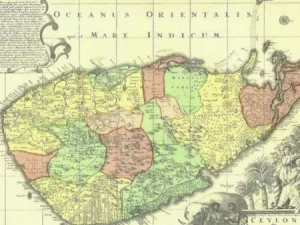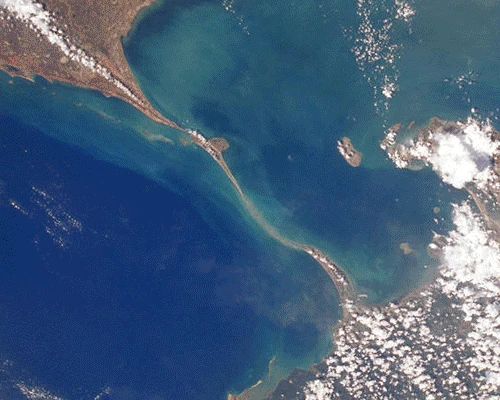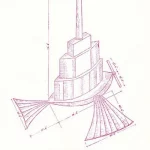Adam’s Bridge, also known as Rama’s Bridge or Rama Setu, is a chain of limestone shoals, between Pamban Island, also known as Rameswaram Island, off the south-eastern coast of Tamil Nadu, India, and Mannar Island, off the north-western coast of Sri Lanka. Geological evidence suggests that this bridge is a former land connection between India and Sri Lanka. The bridge is 50 km long and separates the Gulf of Mannar from the Palk Strait. Some of the sandbanks are dry and the sea in the area is very shallow, being only 1 to 10 metres deep in places, which hinders navigation.
It was reportedly passable on foot up to the 15th century until storms deepened the channel: temple records seem to say that Adam’s Bridge was completely above sea level until it broke in a cyclone in 1480.
The Geological Survey of India – GSI conducted research which showed that the bridge is built of stone blocks measuring 1.5 x 2.5 m with regular shapes, consisting of limestone, sand and corals. These blocks lie on sea sand, the layer of which is 3-5 m thick, and underneath there is hard, stone ground.
On Arabic medieval maps, the Rama Bridge appears in its entirety, and it was possible to cross it from India to Ceylon with dry feet.

According to Muslim verbal messages, Adam, expelled from paradise, came down to earth in Ceylon, and then crossed to India on a sandbank resembling a bridge.
In Hindu mythology, specifically in the book of Ramayana, Rama’s Bridge is described as a structure commissioned by God Rama to the monkey army led by their king Hanuman. The construction was led by Nala, the son of the divine Viśvakarmana, and the purpose of building the bridge was to transfer troops and fight the demon ruler of Lanka, Ravan, who had kidnapped Sita, Rama’s wife/bride.
Folk lore in India says that the Rama Bridge was built by monkey warriors who were of great height and measured between 4 and 8 meters in height.
Other verbal messages say that stone blocks were transported by air using “divine spells”, which may suggest an unknown for us technology.
The age of this formation is unknown, there are many contradictory hypotheses saying that the Adam/Rama Bridge was built 20,000 years ago as well as 17 million years ago.
Taking into account the physical tangibility of the existing underwater structure, and historical records, I can draw my own conclusions:
– the bridge, or rather its remains, still exists today
– it consists of regular blocks, so it was built, which means that it is not a natural structure
– the bridge was probably destroyed by a typhoon/cyclone in 1480
– according to cerful calculations, the bridge was built before the great flood, so the sea and ocean level was much lower, which made its construction easier
– they built creatures much larger than humans, to say it simply, giants, which is further proof of their existence in the past -> were-there-giants-on-earth
– the construction of the bridge was ordered by a Hindu God, which, in the understanding of a man of the technical era, was a representative of a foreign, more developed civilization
So the big question for today is: in ancient India, long before the flood, representatives of an alien civilization lived on earth, and one of them ordered to build a land connection across the sea?
Was the unknown method of transporting stone blocks by air anti-gravity technology, acoustic levitation, or something else?
See also: https://en.wikipedia.org/wiki/Adam%27s_Bridge
The map image source: Wilfriedbluhm.de





